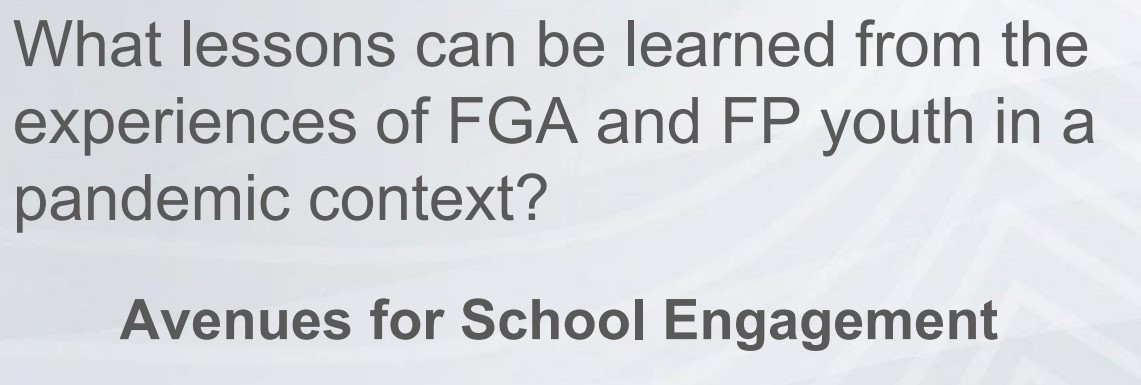Addresses FGA and FP student well-being and the link to teacher/student collaboration, by Nadia Rousseau Ph.D. . A must read!
The Guidance-Oriented Approach
A guidance-oriented approach is a concerted approach by a school team and its partners, in which objectives are set and services (individual and collective), tools and pedagogical activities implemented to guide students in their identity development and career planning. Furthermore, “these activities and services are integrated into the school’s success plan and its educational project; they are not simply a series of isolated actions in which the school team is not closely involved” (Making Dreams Come True: Achieving Success Through the Guidance-Oriented Approach, MEQ, 2002, p.18).
There are 3 major areas of guidance and counseling in schools, Educational, Vocational and Personal-social. Click on the headings below for examples.
Educational Support
The main focus of educational guidance and counseling is to provide support for students who are struggling academically. In a school setting for instance, many students need to improve skills related to reading and writing, language acquisition, comprehension, Math concepts, study habits, examination writing and executive functioning.
Vocational Support
This nature of guidance and counseling is concerned with students who need assistance in the making of realistic vocational decisions. For example there is need to help students; evaluate their strengths, likes, choose the right courses and subject combination that relates to their future career, know what’s available and how to secure a given job, develop effective search skills and know about different occupational hazards of said jobs.
Personal and Social Support
This is concerned with helping students to take acceptable decision on personal, social and psychological issues. For example, there is need to assist students resolve personal social problems related to friends, mental health, coping with peer pressure, improving on interpersonal relationships with people, coping with potential parental quarrels at home and refraining from making bad decisions that might effect their health and their future options.
Case Study of Kirkland Adult Centre
Kirkland Adult Centre wants to examine their intake process, student orientation and support model. They work from the premise of, where are we now, where do we want to go and how do we get there. They begin by having a meeting with all stakeholders involved. They include teachers, guidance counselors, consultants, support staff, the TOS and the director. They decide to use process mapping as a procedure to examine all aspects of how first communication is done all the way to supporting the students once they are in the centre. They take time to analyze the current procedures making notes of what they want to keep, what needs tweaking and what needs to go. They also take time to acknowledge the staff they currently have and the possibility of hiring new staff, if budgets allow. A critical path is developed for when they would like the initiative to come to fruition. They then work backwards and identify key areas and spots that need to be in place for the project to move forward.
 As they begin the process, they realize that the logistics of contacting and registering students needs tweaking. There was redundancy when contacting students, but reminding the students when their registration was, proved difficult without an automated system. This was noted. The group also realizes having up-to-date information is key so students are supported throughout this process. Collaborative tools like Google and others are discussed. Support for students once they are registered and in the centres, is tackled due to the high-rate of special needs students. The topic of food security is also discussed and thus the group decides to send out a survey to get an idea of the number of students coming to school without having breakfast. Ongoing support is examined. The group talks about academic, social and career support and the best ways to accomplish this.
As they begin the process, they realize that the logistics of contacting and registering students needs tweaking. There was redundancy when contacting students, but reminding the students when their registration was, proved difficult without an automated system. This was noted. The group also realizes having up-to-date information is key so students are supported throughout this process. Collaborative tools like Google and others are discussed. Support for students once they are registered and in the centres, is tackled due to the high-rate of special needs students. The topic of food security is also discussed and thus the group decides to send out a survey to get an idea of the number of students coming to school without having breakfast. Ongoing support is examined. The group talks about academic, social and career support and the best ways to accomplish this.
 The group strategizes about training needs of teachers and the procedures that must be put in place. It is decided that teachers will need training on career coaching and sensitivity training regarding cultural difference when it comes to employment choices and preferences.
The group strategizes about training needs of teachers and the procedures that must be put in place. It is decided that teachers will need training on career coaching and sensitivity training regarding cultural difference when it comes to employment choices and preferences.
They decide a meeting with the Directors, guidance and teachers regarding their students would take place every 2 months. Students would be guided in September to develop an educational project in collaboration with the guidance team. Meetings would be made with each student quarterly to check in with the student and go over the plan and discuss new career options.
Once the plan is drawn up completely, it will go to the Governing Board for approval.
Resources

There are tons of stimulating jobs in the labour market. When it comes to choosing a career, you can count on help. Discover jobs related to your hobbies, interests and aspirations.


